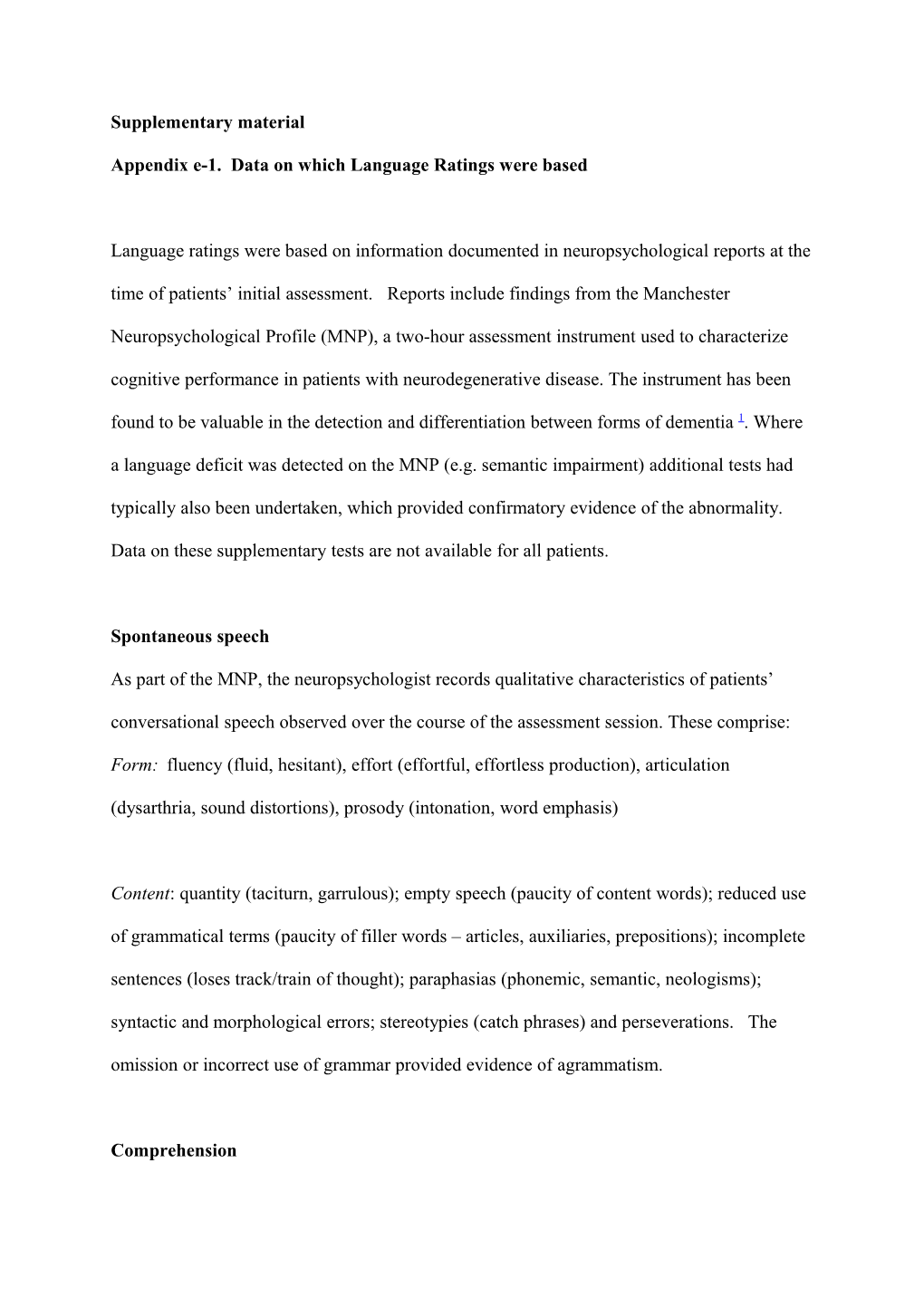Supplementary material
Appendix e-1. Data on which Language Ratings were based
Language ratings were based on information documented in neuropsychological reports at the time of patients’ initial assessment. Reports include findings from the Manchester Neuropsychological Profile (MNP), a two-hour assessment instrument used to characterize cognitive performance in patients with neurodegenerative disease. The instrument has been found to be valuable in the detection and differentiation between forms of dementia1.Where a language deficit was detected on the MNP (e.g. semantic impairment) additional tests had typically also been undertaken, which provided confirmatory evidence of the abnormality. Data on these supplementary tests are not available for all patients.
Spontaneous speech
As part of the MNP, the neuropsychologist records qualitative characteristics of patients’ conversational speech observed over the course of the assessment session. These comprise:
Form:fluency (fluid,hesitant), effort (effortful, effortless production), articulation (dysarthria, sound distortions), prosody (intonation, word emphasis)
Content: quantity (taciturn, garrulous);empty speech (paucity of content words);reduced use of grammatical terms (paucity of filler words – articles, auxiliaries, prepositions);incomplete sentences (loses track/train of thought); paraphasias (phonemic, semantic, neologisms);syntactic and morphological errors; stereotypies (catch phrases) and perseverations. The omission or incorrect use of grammar provided evidence of agrammatism.
Comprehension
Single word
The MNP includes pointing to named objects and body parts and low frequency terms (e.g. something transparent) and a 40-item word-picture matching test (10 animals, 10 fruit/vegetables, 10 clothing, 10 objects), using pictures from the Snodgrass and Vanderwart corpus2. Thesetasks are sufficiently undemanding to elicit ceiling level performance in healthy controls.
Supplementary comprehension tests, available for some patients (when semantic impairment was suspected),include The Pyramids and Palm Trees test of Semantic Association3 and the PALPA synonyms test4.
Sentence
The MNP incorporates an 8-item sentence comprehension screen, which includes reversible sentences (e.g. “If the tiger is killed by the lion which animal is dead?”). The Test of Reception of Grammar5was used as a supplementary task.
Repetition
The MNP assesses digit and word span for monosyllabic and polysyllabic words. It also includes repetition of four short phrases (e.g. “an uncommon animal”). Errors in repetition (e.g. transposition of phonemes) are reported.
Naming
Confrontation naming was assessedfor most patients by a) a locally developed ‘easy’ 40-item naming test1that uses the same 40 items as the word-picture matching task and elicits scores approaching ceiling level in healthy controls, and b) the more demanding Graded naming test 6. A minority of patients had been administered a shortened version of the Boston naming test7. The MNP records error types in naming, including the presence of semantic and phonemic errors, and functional descriptions. A semantic basis to naming impairment was inferred only when errors indicated a) loss of semantic discrimination (the presence of coordinate category errors e.g. ‘dog’ for lion) or b) failure to recognize objects despite preserved basic perceptual skills (e.g. preserved ability to copy line drawings; preserved performance on subtests of the Visual Object and Space Perception Battery8that do not require recognition of identity).
Reading
The MNP includes reading a series of letters, numbers, regular and irregular words and a complete passage of prose. This screening test of reading permits elicitation of surface and deep dyslexic errors. Supplementary reading tasks include PALPA imageability and frequency and regularity reading tests4.
Writing
The MNP includes asking the patient to generate a sentence and write a sentence to dictation, which includes the irregular word ‘caught’. Supplementary tasks include PALPA imageability and frequency and regularity writing tests4.
Praxis
The MNP includes a screen of orofacial and limb praxis, including production of repetitive and alternating speech sounds.
References
1.Snowden J, Thompson JC, Stopford CL, et al. The clinical diagnosis of early-onset dementias: diagnostic accuracy and clinicopathological relationships. Brain 2011;134:2478-2492.
2.Snodgrass JG, Vanderwart M. A standardized set of 260 pictures: norms for name agreement, image agreement, familiarity, and visual complexity. J Exp Psychol Hum Learn 1980;6:174-215.
3.Howard D, Patterson K. The Pyramids and palm trees: a test of semantic access from pictures and words. Bury St Edmunds, Suffolk: Thames Valley Test Company, 1992.
4.Kay J, Lesser R, Coltheart M. Psycholinguistic assessment of language processing in aphasia. Hove, Uk: Psychology Press, 1992.
5.Bishop D. Test for the reception of grammar (TROG). London: Pearson Assessment, 2003.
6.McKenna P, Warrington EK. Graded Naming Test. Windsor: NFER-Nelson, 1983.
7.Kaplan E, Goodglass H, Weintraub S. The Boston Naming Test. In. Philadelphia: Lea & Febiger, 1983.
8.Warrington EK, James M. Visual Object and Space Perception Battery (VOSP). London: Pearson Assessment, 1991.
